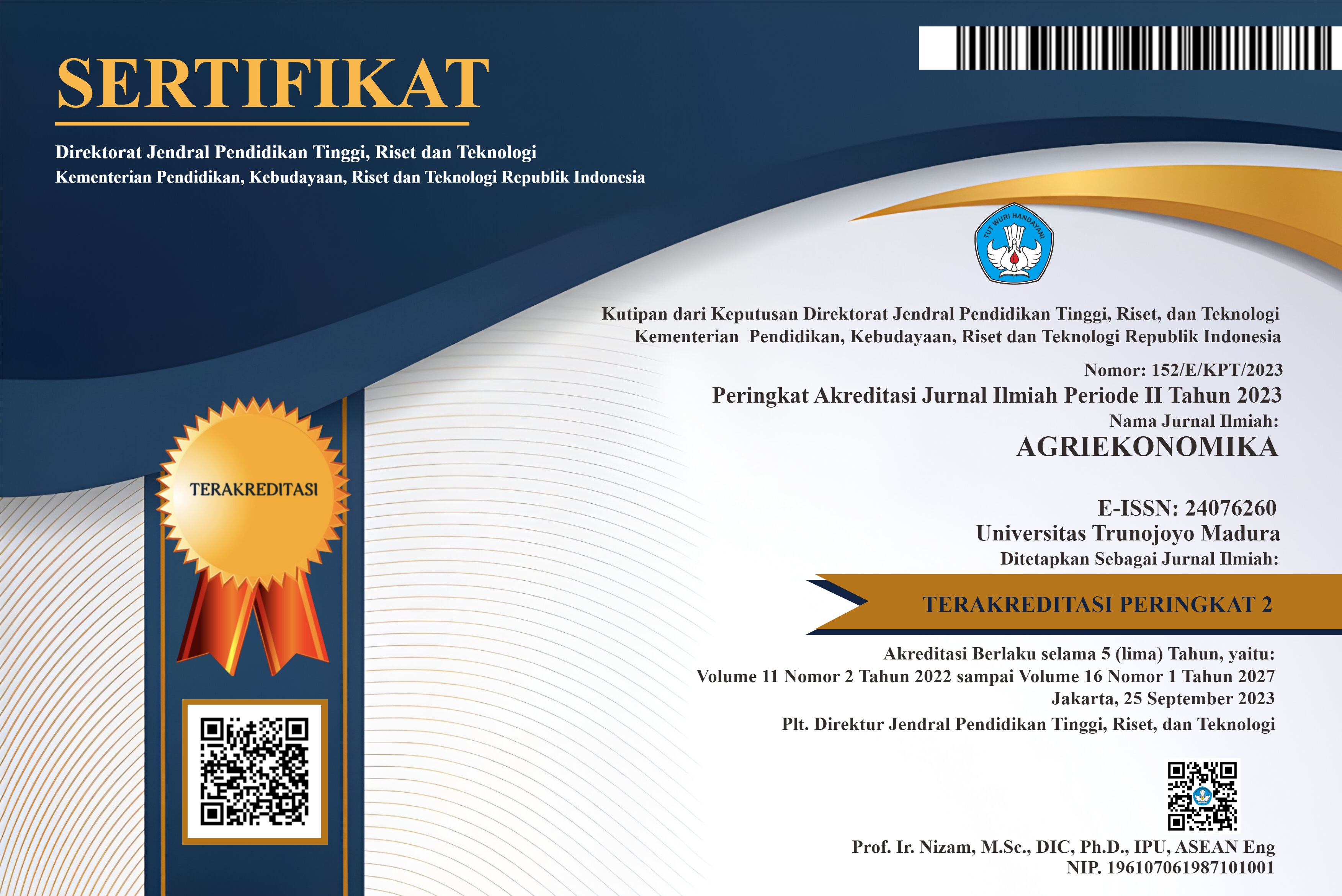ANALISIS PENGEMBALIAN KREDIT KETAHANAN PANGAN DAN ENERGI (KKP-E) PETANI PADI DI KABUPATEN KUDUS
Abstract
Tujuan penelitian untuk mengetahui : (1) tingkat pengembalian KKP-E yang sudah dibayarkan oleh petani padi dan untuk mengetahui tingkat kelancaran serta kemampuan pengembalian KKP-E dan (2) faktor-faktor yang mempengaruhi tingkat pengembalian KKP-E oleh petani padi di Kabupaten Kudus. Metode yang digunakan adalah analisis deskriptif. Sampel yang digunakan sebanyak 31 responden petani padi yang mengambil KKP-E yang telah jatuh tempo pengembalian kredit. Hasil penelitian menunjukkan bahwa tingkat pengembalian KKP-E di Kabupaten Kudus dikategorikan lancar dan tepat waktu dengan persentase tingkat tunggakan adalah sebesar 8%, Faktor-faktor yang mempengaruhi keberhasilan pengembalian KKP-E padi di Kabupaten Kudus secara parsial signifikan berpengaruh adalah jumlah pinjaman, lama usahatani, luas lahan, serta umur. Sedangkan yang tidak signifikan berpengaruh adalah pendapatan usahatani, pendidikan, jumlah tanggungan keluarga dan dummy wilayah. Secara simultan, faktor-faktor independen bersama-sama mempengaruhi jumlah pengembalian KKP-E padi (F sig < α = 5%). Nilai adjusted R2 adalah 0.883 atau 88.30%.
ANALYSIS OF REPAYMENT OF ‘FOOD AND ENERGY SECURITY’ CREDIT AMONG RICE FARMERS IN KUDUS REGENCY
ABSTRACT
The aims of this study are (1) to find out various uses of ‘Food and Energy Security’ Credit (Kredit Ketahanan Pangan dan Energi—KKP-E) and its proportion used in rice farming among farmers in Kudus Regency, (2) to examine the repayment of KKP-E ever paid by the rice farmers as well as the smoothness and ability of repaying the credit and (3) to identify the factors affecting the repayment rate of KKP-E by rice farmers in Kudus Regency. This study to collect a sample of 31 respondents among rice farmers taking KKP-E with the expired credit repayment.. The results of the credit repayment rate in Kudus Regency was categorized as smooth and timely with a percentage of back payment was 8% and the factors affecting the success of credit repayment were the amount of credit, farming period, land size, and age, while the factors that did not affect it were farming income, education, number of family member, and dummy of regions. All the independent factors simultaneously affect the amount of KKP-E repayment for rice commodity was F < α = 5%. The value of adjusted R2 was 0,.883 or 88,.30%.
Keywords
Full Text:
PDFReferences
Ashari. (1990). Peran Perbankan Nasional Dalam Pembiayaan Sektor Pertanian Di Indonesia Roles of National Banking in Agricultural Finance in Indonesia, 13–27.
Baroroh, A. (2013). Analisis Multivariat dan Time Series Dengan SPSS 21. Jakarta: Kompas Gramedia.
Edem, I. D. (2014). Evaluation of Agricultural Credit Facility in Agricultural Production and Rural Development, 14(3), 37–46.
Kementan. (2010). Laporan Akhir Pusat Analisis Sosek dan Kebijakan Pertanian (Realisasi Penyaluran KKPE Tingkat Nasional). Jakarta.
KKPE, P. (2014). Pedoman Teknis Kredit Ketahanan Pangan dan Energi (KKPE).
Lv, G., Yu, B., Chen, Z., Zhou, Z., & Shi, Y. (2012). The analysis of peasant household’s credit behavior. Procedia Computer Science, 9, 1228–1233. https://doi.org/10.1016/j.procs.2012.04.133
Muljono, T. P. (2001). Manajemen Perkreditan Bagi Bank Komersil. Yogyakarta: BPFE.
Nugraheni, noer ayu. (2012). ( KKP-E ) BRI TERHADAP PENDAPATAN PETANI PADI DI KABUPATEN KARANGANYAR
Obilor, S. I. (2013). The impact of commercial banks ’ credit to agriculture on agricultural development in Nigeria : An econometric analysis. International Journal of Business, Humanities and Technology, 3(1), 85–94.
Ridwan dan Kuncoro. (2011). Cara Menggunakan dan Memahami Path Analysis (Analisis Jalur). Bandung: Alfabeta.
DOI: https://doi.org/10.21107/agriekonomika.v6i2.3052
Refbacks
- There are currently no refbacks.







